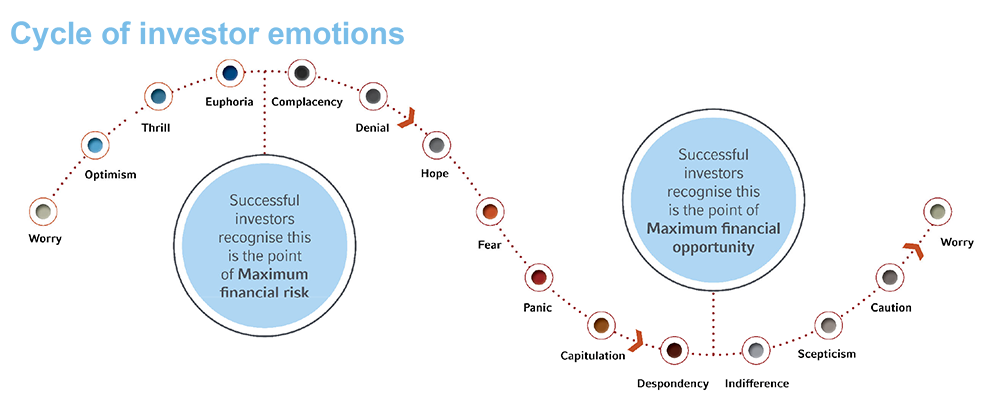The cycle of investor emotions
When financial markets experience an upward or downward spike it can be difficult to not get caught up in the hype. From attention-grabbing news headlines to predictions from industry economists – it seems everyone has a different opinion on what markets will do next, and the best action to take. But when it comes to your investments, the best strategy is to remain focused on the long-term, and not be swayed by emotions.
Initially as investors, we all start with optimism. We commonly expect things to go our way and tend to expect a reward for the risk of investing.
As our expectations are met, we get excited about the possibility of even greater returns, and the excitement becomes thrilling as the returns exceed our expectations. We are at the top of the cycle when we experience euphoria. But it is at this point that we also experience maximum financial risk. When we believe everything that we touch turns to gold, we fool ourselves into believing that we can beat the market, that we cannot make mistakes, that excessive returns are commonplace, and that we can tolerate higher levels of risk.
This euphoria was experienced by many investors at the start of 2020, prior to the Covid-19 outbreak and subsequent economic fallout. Global stock markets were at all-time highs as a result of the longest bull market in history, and many investors expected this trend to continue.
The second phase of the cycle begins when the market stops meeting our new lofty expectations and begins to turn. At first, we anxiously watch the market for any signs of direction. Anxiety turns to denial and then to fear as the value of our investments decline. We start to act defensively and may think about switching out of riskier assets to more defensive investments such as bonds.
In the third phase of the cycle, the realities of a bear market come to the fore and we become desperate. Many of us panic and withdraw from the market altogether – afraid of further losses. Those who persevere become despondent and we wonder whether markets are ever going to recover, and whether we should be invested in them at all.
Ironically, at these times, we commonly fail to recognize that we are actually at the point of maximum financial opportunity.
The five most common behavioural pitfalls are:
- Overconfidence
When investors overrate their ability to select winning shares or investment managers. - Loss aversion
Research indicates that a loss causes about twice as much pain as a gain causes pleasure. During periods of market volatility investors experience the sense of loss more acutely. - Chasing past performance
We see this time and time again, but unfortunately, individual investors who are abandoning a well-diversified portfolio for bonds, or even cash, may be jeopardising their future financial security. - Timing the market
Research shows that no-one can accurately time the market. - Failure to rebalance
The risk/return characteristics of an investor’s portfolio should be independent of what’s happening in the market and this means selling high and buying low.
The temptation to fall into one of these traps can be resisted by developing and committing to a well-defined, long-term investment policy. This is the best way to protect yourself from your emotions.
